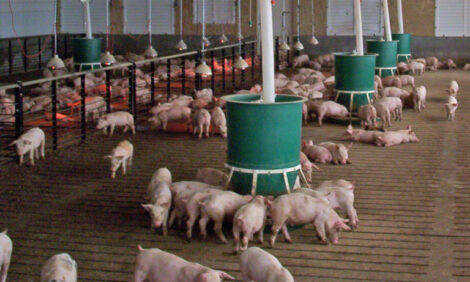



Trailer Design Affects Market Pig Welfare
Trailer design may be one of several factors that influence the level of stress for pigs being transported, according to Tom Guthrie, Extension Educator for the Pork Team at Jackson in his review of trials on this topic in the latest Pork Quarterly from Michigan State University.Transportation of livestock in general has created a significant amount of interest in regard to animal welfare, primarily transport losses. Transport losses are referred to as pigs that die or become non-ambulatory, i.e. unable to walk, during any part of the marketing process. These losses may be identified as a multi-factorial problem which includes factors such as human-animal interaction, the environment of the animal and the individual animal.
Ritter and co-workers (2008) reviewed 22 field studies containing more than four million pigs and reported that mortality losses averaged 0.25 per cent (10,000 out of four million hogs). In addition, Fitzgerald et al. (2009) collected data on more than two million pigs transported from nine farms to a single packing plant and also observed a mortality rate of 0.25 per cent. Furthermore, transport losses represent multiple challenges to the entire US food chain with major implications to animal well being and economics such as direct financial losses to the pork producer and pork processor. Trailer design may be one of the many factors that may influence the level of stress for pigs being transported.
Trailer Types
In a study by Kephart et al (2010), the unloading of 41,474 market pigs was observed that represented 242 trailer loads (171 pig average per load).
Trailer types used in this study included:
- potbelly (PB) with a standard roll up door (37 inches wide)
- straight-deck conventional (SDC) with a roll-up unloading door 37 inches wide, and
- straight-deck wide-opening (SDW) with a standard roll-up door (37 inches wide) and an additional hinged door (31 inches wide) adjacent to the roll-up door for a total opening of 68 inches.
In this study, 73 loads were delivered on potbelly trailers, 88 loads delivered on straight-deck conventional trailers and 81 loads on straight-wide trailers.
Results of this study (Table 1) indicated that the percentage of pigs exhibiting open-mouth breathing transported on potbelly trailers was greater than that of pigs transported straight deck conventional and straight-deck wide-opening trailers. The observation of more pigs exhibiting open-mouth breathing and skin discoloration that were unloaded from potbelly trailers may be directly related to pigs loaded in the 'belly' of the trailer and pigs loaded in the front compartment of the middle deck had to negotiate an internal ramp of approximately 20. compared to the other two types of trailers in which no internal ramps were used.
| Table 1. Influence of trailer type on pig behaviour | ||
|---|---|---|
| Trailer type | Open-Mouth Breathing (%) |
Unloading Time (min.) |
| Potbelly | 2.99 | 17.3 |
| Straight | 1.62 | 12.4 |
| Straight-wide | 0.66 | 10.3 |
| Adapted from Kephart et al., 2010 | ||
Similar results were reported by Ritter et al (2008) that studied the effects of season and distance moved during loading on transport losses of market-weight pigs comparing two different trailer types. In this study, 109 loads of pigs were evaluated (53 loads loaded and transported on a potbelly trailer and 56 loads loaded and transported on a straight deck trailer, respectively). Results indicated that signs of open-mouth breathing in pigs unloaded from potbelly trailers were greater in the spring and summer than pigs unloaded from the straight-deck trailer type. Additionally, the incidence of skin discoloration was greater in pigs unloaded from potbelly trailers in the spring, summer and winter.
Loading times were similar for the two trailer types, however, the time to unload was considerably greater for the potbelly trailers (Table 2). This could be attributed to the difficulty experienced by handlers to move pigs easily from the potbelly trailer. Therefore, pigs may experience greater stress during unloading from the potbelly trailers compared to straight deck trailers. Moreover, it should be noted that there was no significant effect of trailer design on either transport losses or carcass trim loss.
| Table 2. Effect of trailer design on physical indicators of stress after loading and unloading | ||
|---|---|---|
| Trailer design | ||
| Item | Potbelly | Straight-deck |
| Open mouth breathing after loading (%) | 9.68 | 11.5 |
| Skin discoloration after loading (%) | 2.81 | 3.58 |
| Muscle tremors after loading (%) | 0.04 | 0.02 |
| Muscle tremors after unloading (%) | 0.22 | 0.13 |
| Loading time (minutes) | 68.7 | 63.7 |
| Unloading time (minutes) | 35.9 | 20.2 |
| Adapted from Ritter et al., 2008 | ||
Take Home Message
In summary, it is imperative that producers and transporters need to be aware of the many factors associated with transportation management of pigs with trailer design being one of those factors.
With proper transportation management practices and an extensive understanding of animal handling techniques, the pork industry can assure that a proactive approach is being taken to address the concerns for animal well being and economics. In turn, this benefits all parties involved including the pigs, pork producers and packing plants.
Resources
- Fitzgerald, R.F., K.J. Stalder, J.O. Matthews, C.M. Schultz Kaster and A.K. Johnson. 2009. Factors associated with fatigued, injured and dead pig frequency during transport and lairage at a commercial abattoir. J. Anim. Sci. 87:1156-1166.
- Kephart, K.B., M.T. Harper and C.R. Raines. 2010. Observations of market pigs following transport to a packing plant. J. Anim. Sci. 88:2199-2203.
- Ritter, M.J., M. Ellis, R. Bowman, J. Brinkman, S.E. Curtis, J.M. DeDecker, O. Mendoza, C.M. Murphy, D.G. Orellana, B.A. Peterson, A. Rojo, J.M. Schlipf, and B.F. Wolter. 2008. Effects of season and distance moved during loading on transport losses of market-weight pigs in two commercially available types of trailers.








